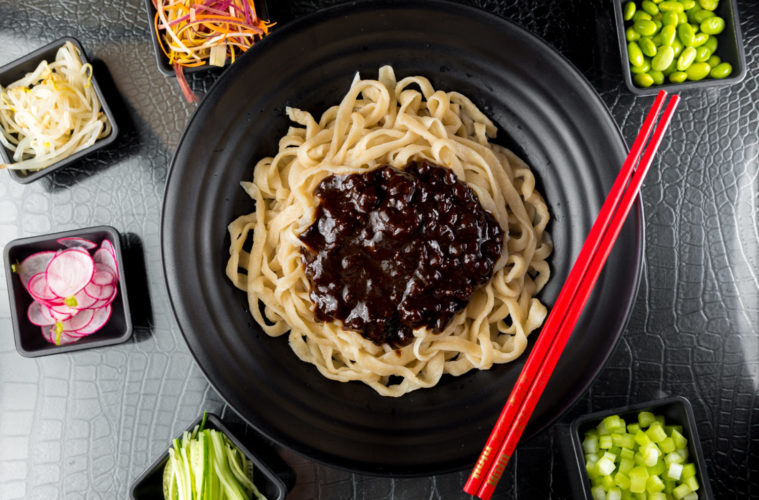Let’s face it, this year will be the anti-New Year’s Eve with all of us staying safer at home in hopes of a better 2021 ahead. And with some extra time on our hands, it’s a good opportunity to explore culinary traditions that will help conjure up the good luck we need.
In the American south, black-eyed peas symbolize coins, cooked greens are the color of money and cornbread is the color of gold. Pork is known to bring good luck on New Year’s Day and lentils are traditionally eaten after midnight to ensure prosperity. In Asian culture, it’s customary to eat long noodles on the first day of the year, with length symbolizing longevity. The Roscas de Reyes king cake celebrates the Epiphany, ending the Christmas season and bringing a year of luck to whoever finds the baby Jesus inside.
Six of L.A.’s most celebrated chefs shared their luckiest recipes with L.A. Weekly to help slide safely into the New Year. And if you’d rather skip the work and just take the credit, most of these dishes are available for takeout and delivery as well. All recipes serve four.
You can also bring the bar home with Penny Pound Ice’s selection of Penny Pouches – portable pre-diluted, pre-frozen, non-alcoholic cocktail mixers … just add booze. Try the Streamliner, inspired by Eric Alperin’s Union Station bar, with pineapple and coconut. It blends well with rum, mezcal, bourbon and cognac.
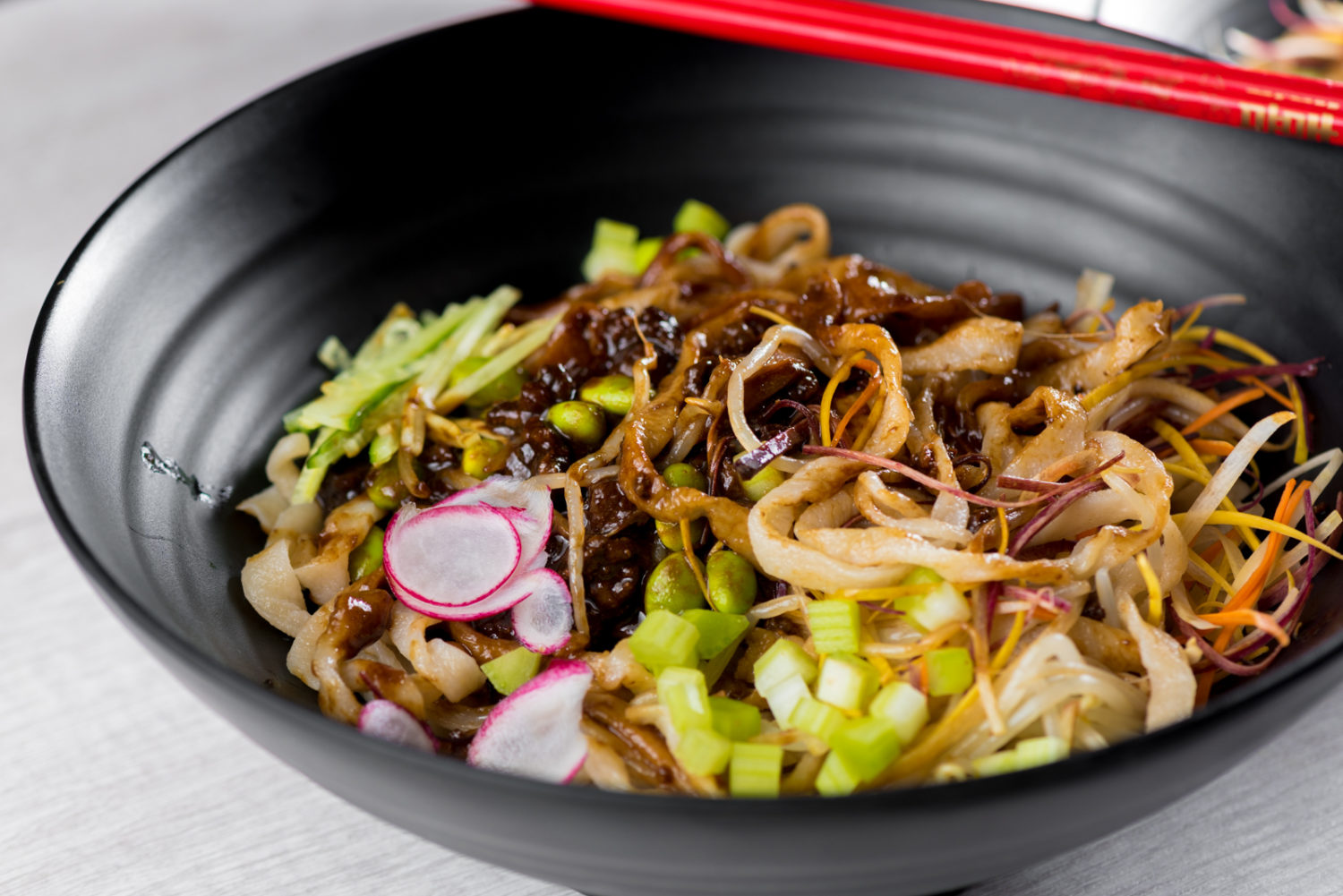
Chef Shirley Chung’s Zhajiang Mian ( Albert Law)
Chef Shirley’s Chung’s Zhajiang Mian from Ms. Chi Café in Culver City
Pork Belly Sauce
1 lb. skin-on pork belly
1 star anise
1 tbsp minced ginger
1 tbsp minced garlic
1 cup sweet fermented bean paste
¼ cup fermented soybean paste
2 tbsp chopped green onions
Hand-Cut Noodles
4 cups all-purpose flour
1 cup water
1 tsp kosher salt
Toppings
2 cups sliced Napa cabbage strips
1 cup sliced cucumber strips
1 cup watermelon radish strips
Directions
To make the sauce, first we need to prep the pork belly. Have your local butcher grind the pork belly through a ½-inch (1.2 cm) hole on the grinding plate. Otherwise, chop and dice the pork belly yourself at home into minced pieces that are similar to coarse ground pork.
Heat up a medium-size cast-iron pan over medium heat. When the pan is hot, add the ground pork belly and start to render the pork fat and brown the meat. Let the ground pork start to turn golden brown and the pork fat start to render out; this will take about 6 to 7 minutes. Add the star anise, ginger and garlic to the pan. Stir-fry everything for a couple of minutes.
Next add the sweet fermented bean paste and the soybean paste to the pan, and mix well. When the sauce comes to a simmer, drop the heat to low. Simmer the sauce for 30 minutes, stirring often so it won’t burn on the bottom. After the sauce is done, add the green onions at the end. If you find the sauce is too greasy at this point, you can cool it down and skim off the pork fat on top. I love fat, so I mix it into my noodles.
While the sauce is cooking, make the hand-cut noodles. Combine the flour, water and salt in a mixer or a heavy-bottom bowl. Knead the dough until smooth, and then rest for 30 minutes. After the dough is well rested, separate it into 4 equal-sized balls and roll them out into large circular sheets with a rolling pin to about ⅛ inch (2 mm) thick. Fold the sheets onto themselves, forming them into a rectangular shape, and then cut them into ¼ inch (6-mm) wide noodles.
To cook the noodles, boil a big pot of water over high heat. Drop the fresh noodles into the boiling water and as soon as the noodles float to the surface, they are done. This will take less than 1 minute. Use the remaining boiling water to blanch the sliced Napa cabbage. Cook for 1 minute, then drain and it’s ready to serve.
To plate the zhajiang mian, put the noodles in a big bowl. Place 3 tablespoons (45 ml) of sauce in the middle and surround with cucumber strips, watermelon radish strips and Napa cabbage. Mix them all together when eating. This dish is available to ship nationwide from Goldbelly.com and will be available as a New Year’s special at Ms Chi Cafe.
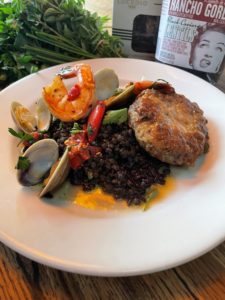
Venetian Black Rice, Beluga Lentils, Housemade Sausage, Clams & Shrimp (Courtesy Little Dom’s)
Venetian Black Rice, Beluga Lentils, House made Sausage, Clams & Shrimp by Chef Brandon Boudet of Little Dom’s in Los Feliz and Little Dom’s Seafood
“I combined two Italian New Year’s traditions for this dish. Serving rice for the holiday is supposed to bring about wealth, reflected in how rice grows and expands in the pot, the way you would like your wealth to grow in the coming year. Lentils resemble coins, ensuring a new year of prosperity. Whatever assurances this dish offers, which is nice and all, the flavors are ones you’ll remember long into 2021,” Boudet tells L.A. Weekly.
Ingredients
1 cup beluga lentils (I recommend Rancho Gordo)
1 cup Venetian black rice
3 cups of chicken stock or clam juice
6 cloves of garlic
2 bay leaves
4 links or patties of your favorite Italian sausage
12 shrimp peeled and deveined
20 little neck clams rinse well under cold water
1/2 cup white wine
1/2 lemon juice
1/2 cup extra virgin olive oil
Crushed red pepper to taste
Salt to taste
Teaspoon of fresh oregano leaves
Tablespoon chopped chives
Tablespoon chopped Italian parsley
8 oz jar of piquillo peppers, roughly chopped
Directions
Add Venetian rice to a pot with a lid, along with 2.5 cups of stock or clam juice, one clove garlic and one bay leaf. Season with salt and bring to boil, then simmer 25-35 minutes. Remove from heat and let sit covered an additional 10 minutes.
Add lentils to a pot and cover with water by one inch. Add one clove garlic and bay leaf, season with salt and simmer 25 minutes until tender. Drain any excess liquid.
In a heavy steel pan with a lid, add one tablespoon of extra virgin olive oil. Add sausage and cook over medium heat until just cooked, remove sausage from pan and pour off half of remaining fat in pan.
Season clams and shrimp with salt and crushed red pepper and add to hot pan, then add two tablespoons of extra virgin olive oil along with garlic. Sauté for 30 seconds, add piquillo peppers, then sauté for 30 more seconds. Add 1/2 stock or clam juice, 1/4 cup lemon juice and 1/4 cup of white wine. Cover and simmer until clams open and shrimp are cooked just through. Add sausage back to pan and finish with the rest of extra virgin olive oil and fresh herbs.
To plate, put rice and lentils down on plate and top with shrimp sausage clam mixture.
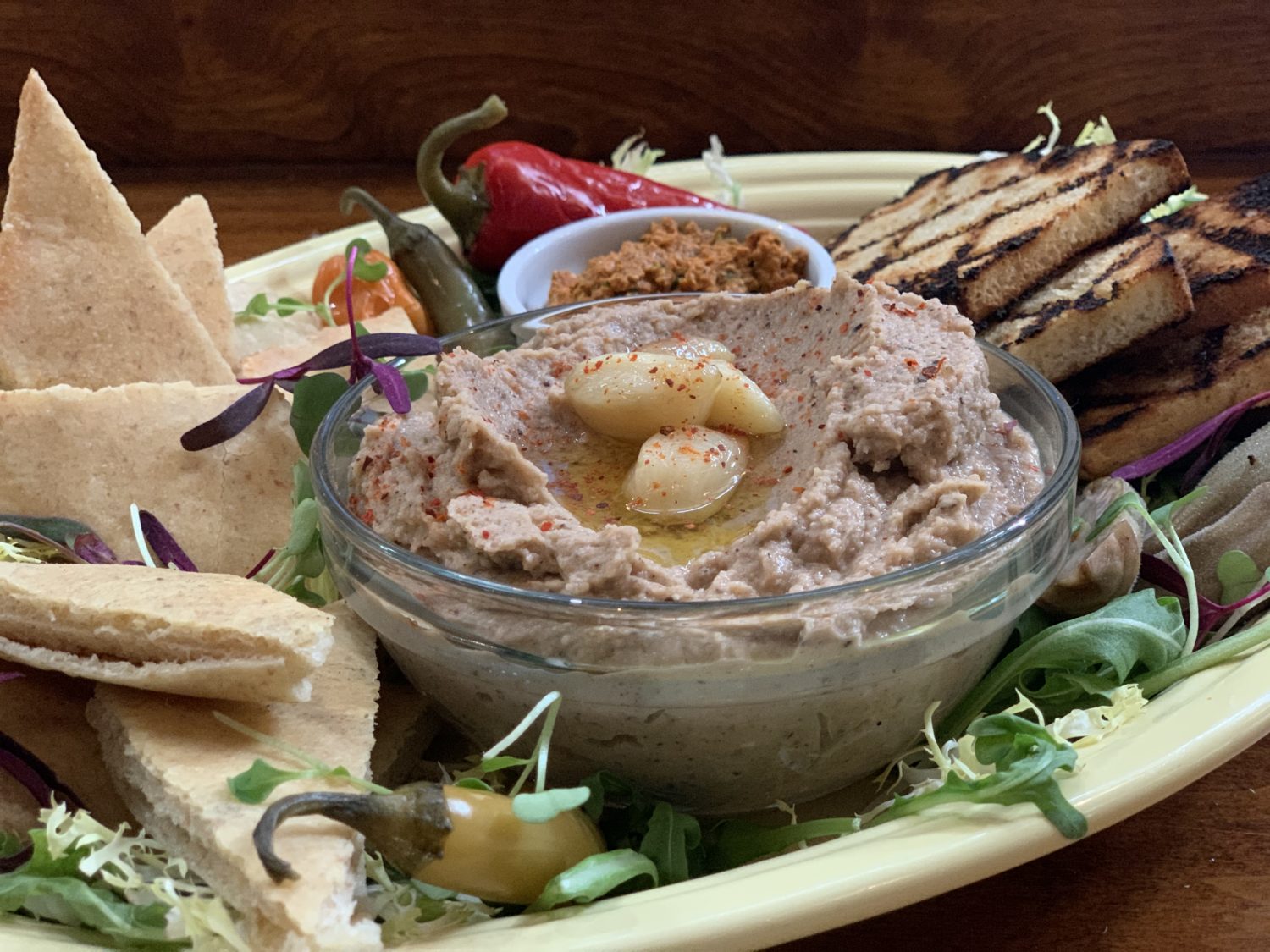
Black Eyed Pea Hummus (Courtesy Post & Beam)
Black-Eyed Pea Hummus, Chef John Cleveland of Post & Beam in Baldwin Hills
Chef John brings a southern twist to hummus, a Middle Eastern favorite, substituting chickpeas for black-eyed peas. He suggests serving the black-eyed pea hummus with crab cakes or your favorite flatbreads alongside a glass of champagne.
Raised in North Carolina, Cleveland turns to his southern roots to create a traditional meal with black-eyed peas to ring in the New Year. “In the South, tradition dictates that every dinner table includes black-eyed peas for luck and prosperity. If you want to start your new year on a good foot, you’ll need a pot of beans,” says the Oakland-born chef.
Ingredients
2 quarts of cooked black-eyed peas
1 cup of reserved cooking liquid from black-eyed peas
2 teaspoons of cayenne pepper
6 roasted garlic cloves
Juice of 4 lemons
2 cups of olive oil blend
2 teaspoons of sumac
1 teaspoon of cumin
Directions
This hummus is best to make while beans are still warm.
Place one quart of cooked beans in blender.
Add half of all the other ingredients and puree until smooth, constantly scraping down.
Season with salt and black pepper and pass through the fine tamis.
Repeat with remaining ingredients and combine the two batches. Adjust seasonings.
Serve with flatbreads.
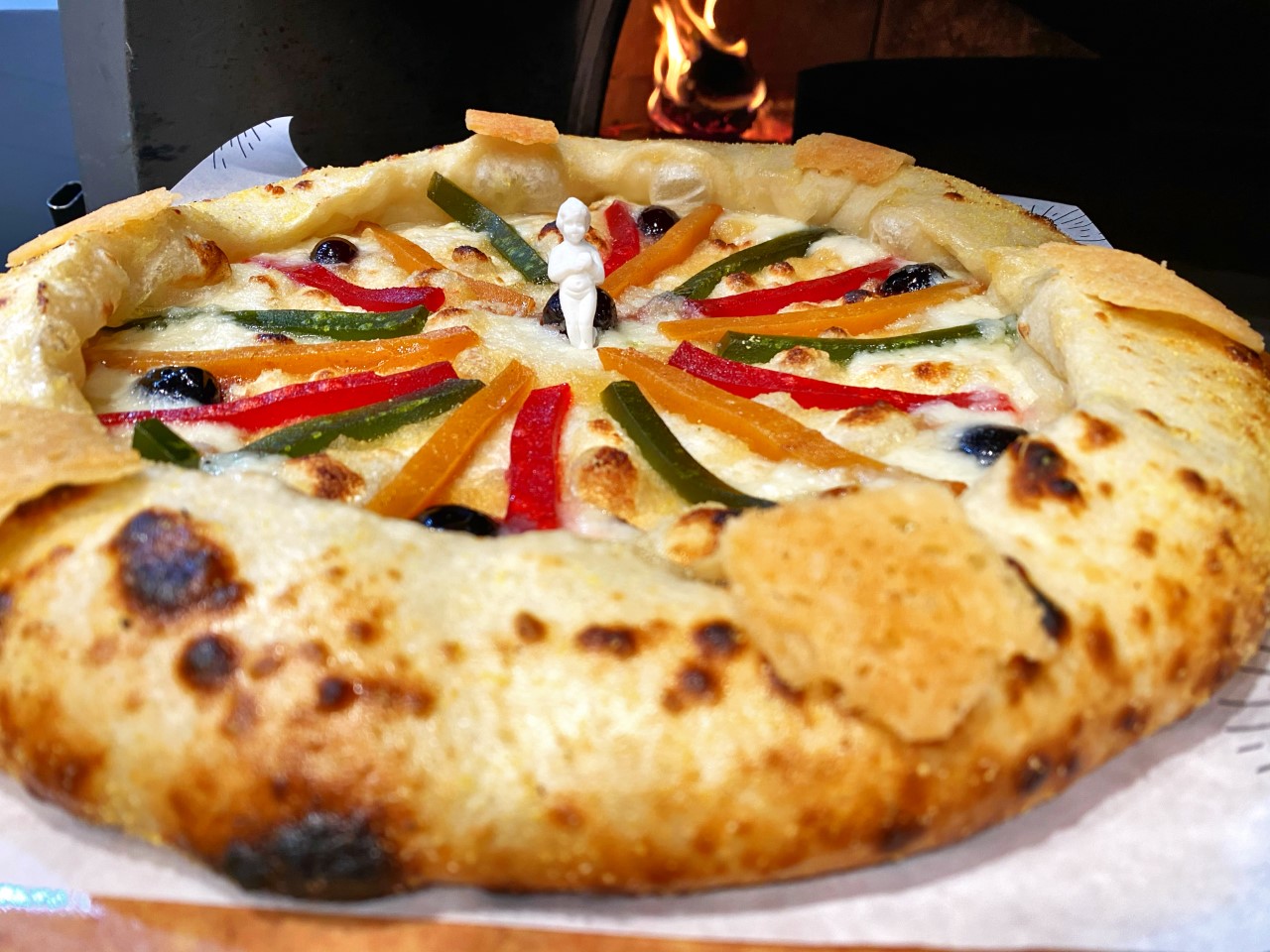
Wood Fired Rosca de Reyes (Courtesy Mario Christerna)
Wood Fired Rosca de Reyes from Chef Mario Christerna, Brooklyn Pizza Co. in Boyle Heights
“I’m a Chicano who comes from a Mexican family and in our culture during the holidays we have many traditions. One of them is to eat Rosca de Reyes. Rosca means a crown, reyes means kings. Rosca de Reyes typically is a sweet bread with dried fruits. In Mexican culture we add candied Ate. Ate is a very thick jelly made of meaty fruits containing pectin. There are different variations of Rosca de Reyes, depending on country or region. In Mexican culture, we place a baby Jesus in the bread and when we eat the Rosca de Reyes, whoever has the baby Jesus in their slice must bring tamales or host a party or any other tradition that one’s household comes up with. Here in Boyle Heights, the neighborhood I was born and raised in, you can find Rosca de Reyes all over. Here’s my favorite version – wood fired in my oven at Brooklyn Ave. Pizza Co.” – Chef Christerna
Ingredients
Dough of your choice (or store-bought pizza dough will do)
Applesauce
3 apples peeled, cored and diced
1 cup granulated sugar
1 cinnamon stick
2 whole cloves
Cheese filling for stuffed crust
2 cups queso fresco
1 tbsp Mexican crema
2 tbsp granulated sugar
Zest of 1 lime
1 baby Jesus
Toppings
3 ounces Ate de Tecojote (manzanita) julienne
3 ounces Ate de Membrillo (quince) julienne
3 ounces Ate de Guayaba (guava) julienne
4 luxardo cherries cut in half
Method
If you have a wood-fired oven, get your oven to 700 degrees. If it’s a home oven, get it at max temp.
In a food processor, add apples and puree. Once pureed, transfer to a small sauce pot, add sugar, cinnamon stick and clove and put on medium heat. Stir with a rubber spatula frequently to not stick. Reduce by half. Set aside to cool. This will be your sauce for your pie.
In a mixing bowl add queso fresco, crema, sugar, lime zest and mix well.
Stretch out your dough or roll with a rolling pin to 13 inches. Place cheese all around the inside of the edges. Put baby Jesus inside a section of the cheese. Fold edges over, covering the cheese and seal by pressing. You can always use a little water on your fingertips to do so. Spread spiced applesauce in the center, just like spreading marinara on a pizza. Place your julienned Ate’s around the middle in a sequence. Place cherries symmetrical in between every 3 strips. Place one cherry in the middle. If oven is at 700, bake for 2 ½ to 3 minutes then dome it. If in a 500-degree oven, bake for approximately 7 minutes. Times will depend on the type of dough you choose to work with or the kind of crust you desire. Keep an eye on the color of your pie.
Slice and enjoy with friends and family.
Bonus tip #1: Enjoy with a glass of Rompope (Mexican version of egg nog)
Bonus tip #2: Ate can be mostly found in local Mexican supermarkets or Mercados around Boyle Heights. Baby Jesus you might have to hunt for at Mexican Panaderias.
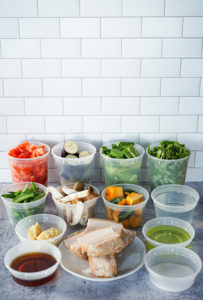
Vegetable Pinakbet with Crispy Pork (Stephanie Valenzona)
Vegetable Pinakbet with Crispy Pork from Vincent Valenzona, Ord & Broadway / Keepers / Broadway Food Group, DTLA
“Inspired by my grandma Valenzona’s family recipe,” Valenzona tells L.A. Weekly. “This dish was served at my family’s chain of restaurants in Manila and is very close to my heart.”
Ingredients
For Crispy Pork Belly
1 pound pork belly
¼ cup kosher salt
2 tbsp whole black peppercorns
1 each bay leaf
1 quart vegetable 0il (For Frying)
For Pinakbet
4 cups large diced tomato
2 cups chopped white onion
3 tbsp minced garlic
3/4 cup fish sauce
1 cup vegetable Oil
¼ cup sugar
4 cups Chinese eggplant (1” Cut Rings)
4 cups baby bok choy (Cut)
2 cups sliced shiitake mushrooms
2 cups kabocha Squash (1” Cubes Skin on and Seeded)
4 cups ong choy (Chopped Leaves Only)
2 cups water
2 cups green beans
Procedure
Crispy Pork Belly
- Place pork belly, kosher salt, whole black peppercorns and bay leaf in a medium size pot.
- Add enough water to cover pork belly.
- Bring to a boil and simmer for 90 minutes or until pork is fork tender.
- Cool down in fridge. At least 2 hours
- Place oil in medium size pot and bring to 350’F.
- Place cooled down pork belly in hot fryer oil and cook until crispy. Approximately 3-4 minutes.
- Remove from fry oil and set aside.
Pinakbet
- Add oil to large to pan/wok. Bring to medium heat and add garlic. Toast garlic for 30 seconds.
- Add tomato and onions. Cook for 5 mins on medium heat.
- Add fish sauce and reduce by half.
- Add kabocha squash and water. Cook for 15 minutes or until squash is soft.
- Add sugar and shiitake mushrooms and cook for 3 minutes.
- Add eggplant and green beans. Cook for 3 minutes.
- Add ong choy and bok choy. Cook for 2 minutes.
- Place in large serving dish.
- Chop crispy pork belly and place on top of vegetables
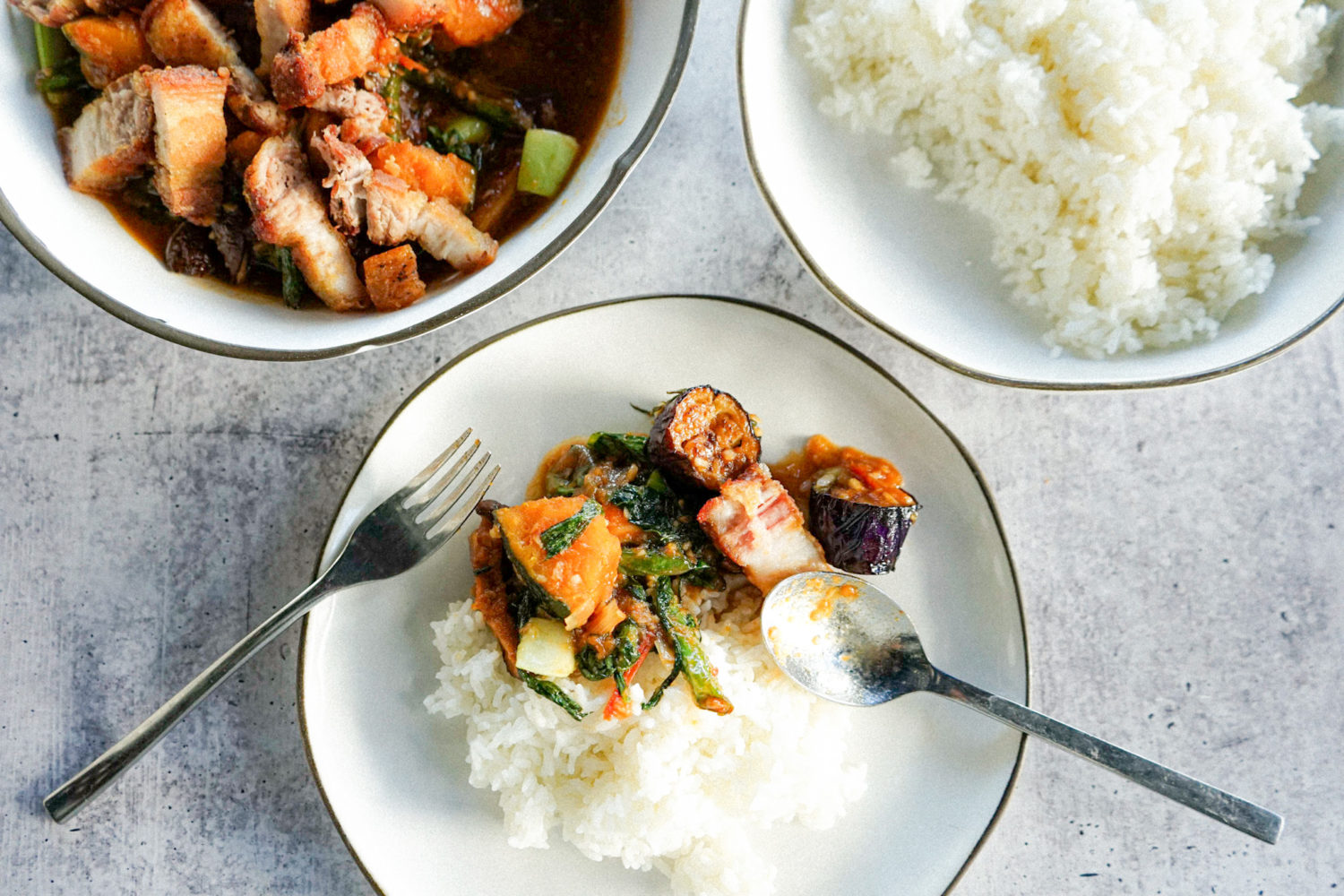
Vegetable Pinakbet with Crispy Pork (Stephanie Valenzona)
Cioppino is an Italian American fish stew that originated in San Francisco in the 1800s by immigrants who lived in the North Beach area and is a traditionally served on New Year’s Eve. When fisherman came back empty handed from the bay, others with an extra catch would fill their pots and the favor would be returned so that families would always stay fed as the tight knit community looked out for each other.
Chef Luigi Fineo’s Livornese Cacciucco (Tuscan Seafood Stew)
Ingredients
2 cloves of garlic
1 small chili
7 springs of Italian parsley
1/2 cup extra virgin olive
1 yellow onion
1 ½ cups peeled San Marzano tomatoes (canned)
3/4 pound monkfish
1/2 pound calamari cut in small rings
3/4 pound peeled and deveined tiger shrimps
1/2 pound mussels
3/4 cup dry white wine
4 slices of country bread
Salt
Pepper
For the fish broth
1 stalk of celery
1 yellow onion
2 cloves of garlic
4 peppercorns
1 bunch of Italian parsley
1/2 cup dry white wine
8 cups of water
1/3 pound shrimps with head and skin
1/3 pound monk fish trimmings
Start by cleaning the fish and shellfish. Clean and cook the mussels. After washing them under running water, remove the barnacles and with an energetic movement remove the byssus that comes out. Then, always under fresh running water, vigorously rub the mussels using steel wool. Sauté over high heat for five minutes with a bit of oil and 1 clove of garlic until they open . At this point you can shell them keeping some whole mussels aside.
To clean the calamari you have to gently detach the head and tentacles from the mantle, wash them well and remove the cartilage pen and ink pouch. Chop the tentacles.
Continue with the monkfish, remove the outer skin divide the pulp following the bone then fillet it, keeping the scraps aside. Clean the prawns with the scissors, remove the tail and the legs leaving the head intact and keeping all the scraps.
For the broth
Peel and chop the onions, celery and garlic and place everything In a saucepan over medium heat with the trimmings from the shrimp and monkfish. Add the whole peppercorns and the parsley and deglaze it with the white wine.
Add the water and bring to a boil, then lower the heat and continue cooking for 40-50 minutes: if necessary, remove the surface foam with a skimmer. Once ready, pour and filter the broth obtained, keeping it aside.
Continue with the cacciucco.
Finley chop onion, garlic and chili and fry them in a large pan sprinkled with olive oil. Add the chopped calamari and let them cook at high heat for five minutes and deglaze with the white wine. Season with salt and pepper then add the previously crushed tomatoes and two cups of the broth.
Cover the pan with a lid and cook over low heat for 1 hour and 10 minutes. When the fish is almost cooked, gently add the monkfish shrimp.
Continue cooking for 10 minutes adding another three cups of broth, covered. At this point, add the shelled and whole mussels and cook for a final 10 minutes.
Meanwhile, slice the bread and toast it for a few minutes in the grill oven for five minutes. When ready, rub a clove of garlic on each slice and finally add the chopped parsley to the cacciucco. The stew is ready to serve hot with toasted bread.
Advertising disclosure: We may receive compensation for some of the links in our stories. Thank you for supporting LA Weekly and our advertisers.

